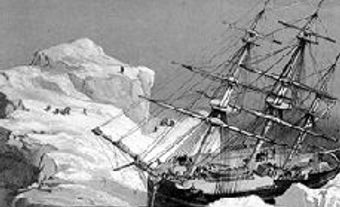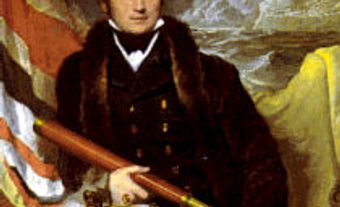
Sir George Strong Nares, naval officer, Arctic explorer (born 1831 at Clytha, Wales; died 15 January 1915 at Kingston upon Thames, England). Nares participated in one of the searches for Sir John Franklin's ships as a mate on HMS Resolute from 1852 to 1854. He is credited with laying the foundations of oceanography through his scientific expeditions. The waterway between Ellesmere Island and Greenland, which Nares crossed in his search for the North Pole, is named for him. During an 1875–76 expedition, Nares reached latitude 82˚27′ N — at the time, the furthest north any European vessel had reached; a party on that expedition also travelled over pack ice to 83˚20′ N.
Early Life and Franklin Search
George Strong Nares was born in Clytha, Wales, in 1831. Nares was educated at the Royal Naval School, New Cross, and joined the navy at the age of 14. After a few years of service in the Pacific on board the HMS Havannah, Nares began his Arctic career.
Nares served as a mate on the HMS Resolute from 1852 to 1854, part of a five-ship expedition led by Edward Belcher. The expedition was in search of Sir John Franklin who, in 1845, had disappeared along with his men while looking for the Northwest Passage. During the search for Franklin, Nares learned about navigating through ice, as well as how to use sledges during land journeys — skills that would become important later in his career.
In 1853, the Resolute came across another expedition in search of Franklin — the HMS Investigator, led by Robert McClure, and frozen off Banks Island. Later, the Resolute also became frozen in ice. It wasn’t until 1854 that the crews of both ships returned to England after being transferred to the North Star (one of the remaining five ships original to Belcher’s expedition). Upon their return, Nares was promoted to lieutenant.
Career
George Strong Nares served in the Mediterranean from 1854 to 1856 before transferring to the Illustrious and then the Britannica, training ships for naval cadets. He wrote a training textbookcalled Seamanship that was reprinted many times. Nares was seen as an energetic instructor with influence over the cadets. His work on the training ships led to his promotion to commander in 1862. He took charge of the Boscawen, another training vessel, before commanding the Salamander in 1865 in Australia. His travels on the Salamander resulted in hydrographic surveys of the coastal waters of Queensland. In 1868, he commanded the Newport in 1868, carrying out surveying work in the Mediterranean before hewas promoted to captain in 1869.
Nares next commanded the Shearwater, which studied the Gibraltar current, before he was selected to command the HMS Challenger on the first major expedition for the scientific study of deep oceans. Between 1872 and 1876, the expedition examined ocean temperature, currents and depths, laying the foundations for almost every branch of oceanography known today. He was recalled only two years into the study in order to lead an Arctic expedition in search of the North Pole.
The British Arctic Expedition: 1875–1876
George Strong Nares was asked to lead the two-vessel British Arctic Expedition of 1875–1876 (made up of HMS Alert and Discovery) partlyas a result of his Arctic experience in search of the Franklin expedition. The British Arctic Expedition aimed to reach the North Pole — a goal based on the mistaken assumption of open Arctic water. Alert reached Floeberg Beach at latitude 82˚27′ N on the northeastern tip of Ellesmere Island before the expedition was forced to use sledging parties to continue northward due to impassable waters. An outbreak of scurvy resulted in several deaths and the eventual withdrawal of the expedition. One party from the expedition, travelling over rough pack ice, made it as far as 83˚20′ N.

Nares was blamed for the outbreak of scurvy as he did not ensure that lime juice was brought onto the sledges. The Royal Navy had introduced lemon juice as a preventative measure against scurvy in the late 1700s, but lime, which contains half as much vitamin C, was substituted for lemon beginning in the 1860s. Some believe the blame was unwarranted considering the challenge of Arctic conditions, which provided little access to fresh food and vitamin C, and the fact that scurvy outbreaks also occurred among the men who remained on the ships and never stopped consuming lime juice.
Regardless, Nares’s expedition resulted in praise as, at the time, no other ship had reached a higher northern latitude. Nares was elected Fellow of the Royal Society in 1875 and knighted by Queen Victoria in 1876. He also received the Founder’s Medal of the Geological Society in 1877 and the Gold Medal from the Geographical Society of Paris in 1879. Nares wrote an account of his expedition in the book Voyage to the Polar Sea. He was appointed rear admiral in 1887 and vice admiral in 1892. Nares surveyed with Alert one more season in the Strait of Magellan before taking a position in the harbour department at the Board of Trade, then retiring in 1896.

 Share on Facebook
Share on Facebook Share on X
Share on X Share by Email
Share by Email Share on Google Classroom
Share on Google Classroom


